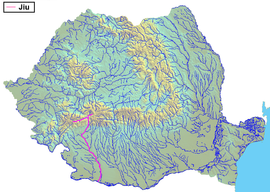| Jiu | |
|---|---|
 View of the Jiu passing Craiova, Dolj County, Romania | |
 The Jiu in Romania | |
| Location | |
| Country | Romania |
| Counties | |
| Cities | |
| Physical characteristics | |
| Source | Confluence of headwaters Jiul de Vest and Jiul de Est, near Petroșani, Hunedoara |
| • coordinates | 45°22′07″N 23°22′04″E / 45.36861°N 23.36778°E |
| • elevation | 554 m (1,818 ft) |
| Mouth | Danube |
• location | near Bechet, Dolj |
• coordinates | 43°46′41″N 23°48′48″E / 43.77806°N 23.81333°E |
| Length | 340 km (210 mi) |
| Basin size | 10,080 km2 (3,890 sq mi) |
| Discharge | |
| • location | mouth |
| • average | 86 m3/s (3,000 cu ft/s) |
| Basin features | |
| Progression | Danube→ Black Sea |
| Tributaries | |
| • left | Jiul de Est, Gilort, Amaradia |
| • right | Jiul de Vest, Motru |
The Jiu (Romanian: [ʒiw] ; Hungarian: Zsil [ʒil]; German: Schil or Schiel; Latin: Rabon) is a river in southern Romania.[1][2] It is formed near Petroșani by the confluence of headwaters Jiul de Vest and Jiul de Est.
It flows southward through the Romanian counties Hunedoara, Gorj, Mehedinți and Dolj before flowing into the Danube near Zăval,[3] a few kilometers upstream from the Bulgarian city of Oryahovo. It is 339 kilometres (211 mi) long, including its source river, Jiul de Vest.[2][4] It has a basin of 10,430 km2 (4,030 sq mi).[2][4][5] Its average discharge at the mouth is 97 m3/s (3,400 cu ft/s).[4]
The upper Jiu Valley, around Petroșani and Lupeni, is Romania's principal coal mining region.
- ^ "Planul național de management. Sinteza planurilor de management la nivel de bazine/spații hidrografice, anexa 7.1" (PDF, 5.1 MB). Administrația Națională Apele Române. 2010. p. 538.
- ^ a b c Atlasul cadastrului apelor din România. Partea 1 (in Romanian). Bucharest: Ministerul Mediului. 1992. pp. 239–255. OCLC 895459847. River code: VII.1
- ^ Jiu (jud. Dolj), e-calauza.ro
- ^ a b c "Danube River Basin District, Part A - Roof Report" (PDF). ICPDR. April 2004. p. 12.
- ^ 2017 Romanian Statistical Yearbook, p. 13